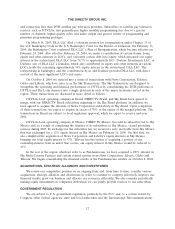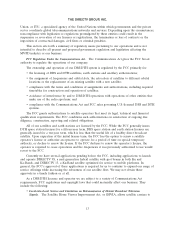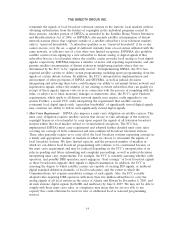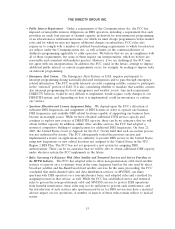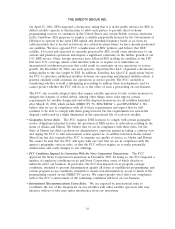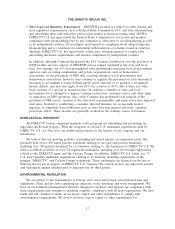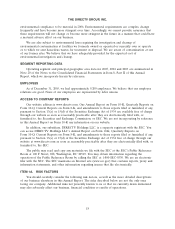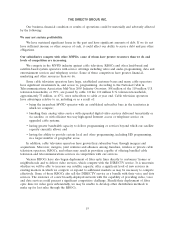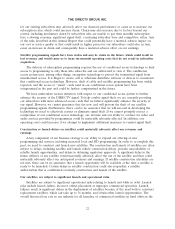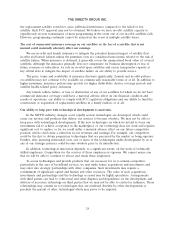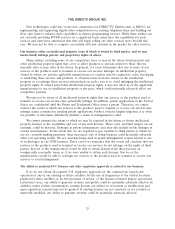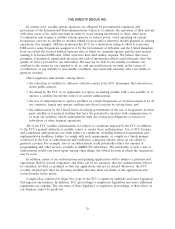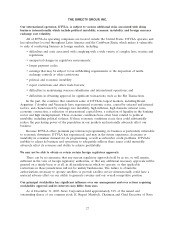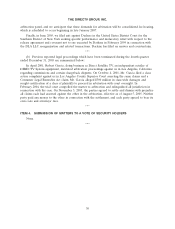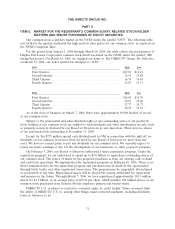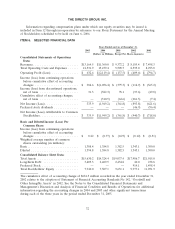DIRECTV 2005 Annual Report Download - page 35
Download and view the complete annual report
Please find page 35 of the 2005 DIRECTV annual report below. You can navigate through the pages in the report by either clicking on the pages listed below, or by using the keyword search tool below to find specific information within the annual report.THE DIRECTV GROUP, INC.
for our existing subscribers may adversely affect our financial performance or cause us to increase our
subscription rates, which could increase churn. Churn may also increase due to factors beyond our
control, including involuntary churn by subscribers who are unable to pay their monthly subscription
fees, a slowing economy, significant signal theft, a maturing subscriber base and competitive offers. Any
of the risks described in this Annual Report that could potentially have a material adverse impact on
our cost or service quality or that could result in higher prices for our subscribers could also, in turn,
cause an increase in churn and consequently have a material adverse effect on our earnings.
Satellite programming signals have been stolen and may be stolen in the future, which could result in
lost revenues and would cause us to incur incremental operating costs that do not result in subscriber
acquisition.
The delivery of subscription programming requires the use of conditional access technology to limit
access to programming to only those who subscribe and are authorized to view it. The conditional
access system uses, among other things, encryption technology to protect the transmitted signal from
unauthorized access. It is illegal to create, sell or otherwise distribute software or devices to circumvent
that conditional access technology. However, theft of cable and satellite programming has been widely
reported, and the access or ‘‘smart’’ cards used in our conditional access system have been
compromised in the past and could be further compromised in the future.
We have undertaken various initiatives with respect to our conditional access system to further
enhance the security of the DIRECTV signal. To help combat signal theft, we are currently providing
our subscribers with more advanced access cards that we believe significantly enhance the security of
our signal. However, we cannot guarantee that the new card will prevent the theft of our satellite
programming signals. Furthermore, there can be no assurance that we will succeed in developing the
technology we need to effectively restrict or eliminate signal theft. If we cannot promptly correct a
compromise of our conditional access technology, our revenue and our ability to contract for video and
audio services provided by programmers could be materially adversely affected. In addition, our
operating costs could increase if we attempt to implement additional measures to combat signal theft.
Construction or launch delays on satellites could materially adversely affect our revenues and
earnings.
A key component of our business strategy is our ability to expand our offering of new
programming and services, including increased local and HD programming. In order to accomplish this
goal, we need to construct and launch new satellites. The construction and launch of satellites are often
subject to delays, including satellite and launch vehicle construction delays, periodic unavailability of
reliable launch opportunities, and delays in obtaining regulatory approvals. A significant delay in the
future delivery of any satellite would materially adversely affect the use of the satellite and thus could
materially adversely affect our anticipated revenues and earnings. If satellite construction schedules are
not met, there can be no assurance that a launch opportunity will be available at the time a satellite is
ready to be launched. Certain delays in satellite construction could also jeopardize a satellite
authorization that is conditioned on timely construction and launch of the satellite.
Our satellites are subject to significant launch and operational risks.
Satellites are subject to significant operational risks relating to launch and while in orbit. Launch
risks include launch failure, incorrect orbital placement or improper commercial operation. Launch
failures result in significant delays in the deployment of satellites because of the need both to construct
replacement satellites, which can take up to 36 months, and obtain other launch opportunities. The
overall historical loss rate in our industry for all launches of commercial satellites in fixed orbits in the
22


